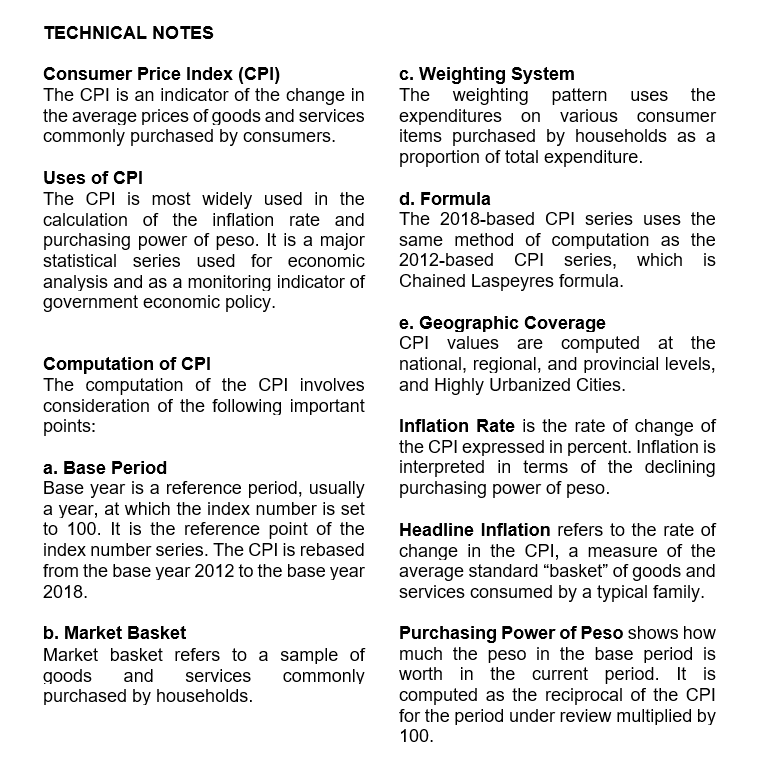Release Date :
Reference Number :
2023-016
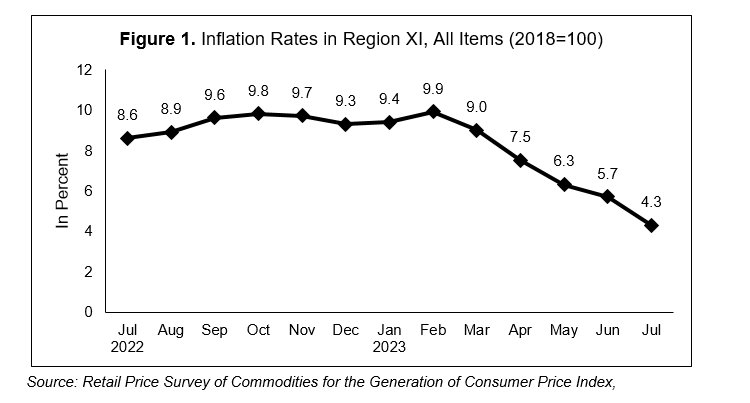
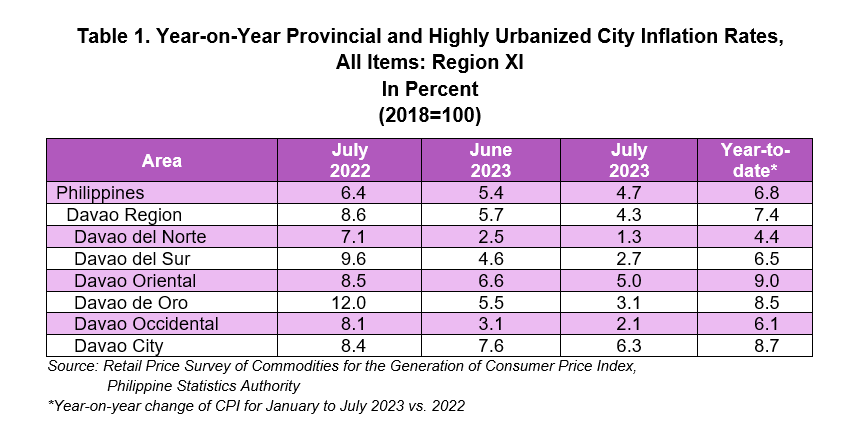
1. Regional Headline Inflation
The year-on-year headline inflation of Davao Region slowed down further to 4.3 percent in July 2023, from 5.7 percent in June 2023. The average inflation rate from January to July 2023 stood at 7.4 percent. In July 2022, the region’s inflation was higher at 8.6 percent. (Table 1 and Figure 1).
1.1 Main Drivers to the Downtrend of the Regional Headline Inflation
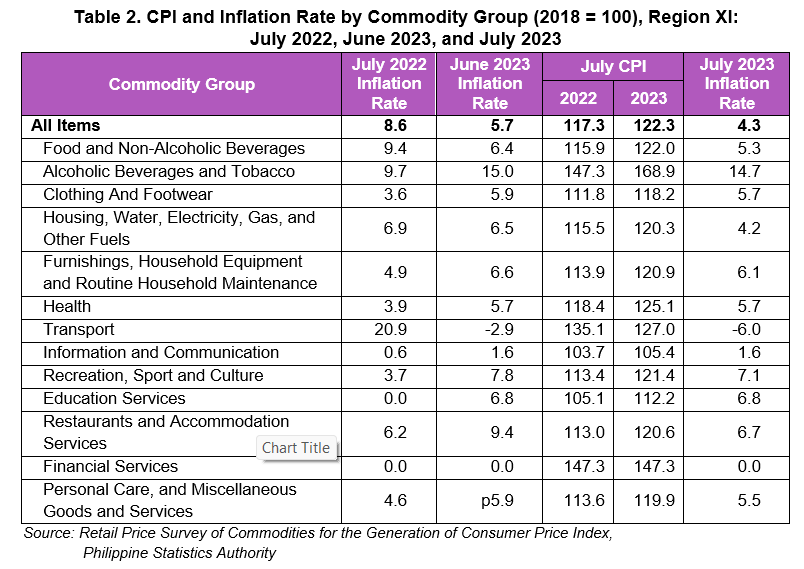
The decline in the region’s overall inflation is mainly due to the slower annual growth rate in Food and Non-Alcoholic Beverages at 5.3 percent in July 2023 from 6.4 percent in the previous month. Additionally, the slower annual increment of Housing, Water, Electricity, Gas and other Fuels at 4.2 percent in July 2023 from 6.5 percent in June 2023 contributed to the downward trend of headline inflation. The third main source of deceleration was Transport which recorded a slower annual decrease of -6.0 percent from -2.9 percent in June 2023. (Table 2)
Furthermore, lower annual growth was also observed in the indices of the following commodity groups compared with their previous monthly inflation rates:
a. Restaurants and Accommodation Services at 6.7 percent;
b. Personal Care, and Miscellaneous Goods and Services at 5.5 percent;
c. Furnishings, Household Equipment and Routine Household Maintenance at 6.1 percent;
d. Alcoholic Beverages and Tobacco at 14.7 percent;
e. Clothing and Footwear at 5.7 percent; and
f. Recreation, Sport and Culture at 7.1 percent.
Meanwhile, the indices for Health, Information and Communication, Education Services, and Financial Services retained their previous month’s inflation rates.
1.2 Main Contributors to the Regional Headline Inflation
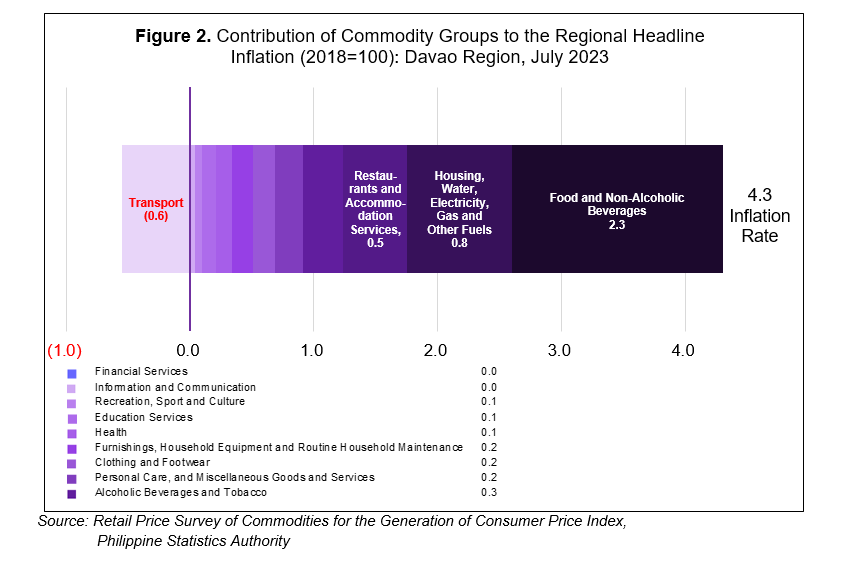
The top three commodity groups contributing to the July 2023 regional headline inflation were the following:
a. Food and Non-Alcoholic Beverages with 2.3 percentage points;
b. Housing, Water, Electricity, Gas and Other Fuels with 0.8 percentage point; and
c. Restaurants and Accommodation Services with 0.5 percentage point. (Figure 2)
2. Davao Region Food Inflation
Davao Region’s Food inflation continued to decelerate at 5.0 percent in July 2023 from 6.1 percent in the previous month. In July 2022, Food inflation was higher at 9.7 percent. (Table 3)

2.1 Main Drivers to the Downward Trend of Regional Food Inflation
The deceleration of food inflation is primarily influenced by the annual decrease in Fish and Other Seafood at -4.8 percent during the month from 0.3 percent in the previous month. This was followed by Meat and Other Parts of Slaughtered Land Animals at 3.5 percent in July 2023 from 5.8 percent in June 2023. Also contributing to the downtrend was the slower year-on-year growth of Corn at 14.0 percent during the month from 21.5 percent in June 2023.
Additionally, the following food groups displayed reduced uptake in their annual growth rates:
a. Sugar, Confectionery and Desserts at 18.4 percent;
b. Milk, Other Dairy Products and Eggs at 9.7 percent;
c. Oils and Fats at 0.0 percent;
d. Flour, Bread and Other Bakery Products, Pasta Products, and Other Cereals at 10.8 percent; and
e. Ready-made Food and other Food Products n.e.c. at 7.4 percent.
Meanwhile, higher year-on-year growth rates were observed in the indices of Rice at 5.2 percent from 2.5 percent; Fruits and Nuts at 13.6 percent from 8.2 percent; and Vegetables, Tubers, Plantains, Cooking Bananas, and Pulses at 9.0 percent from 5.2 percent.
2.2 Main Contributors to the Regional Food Inflation
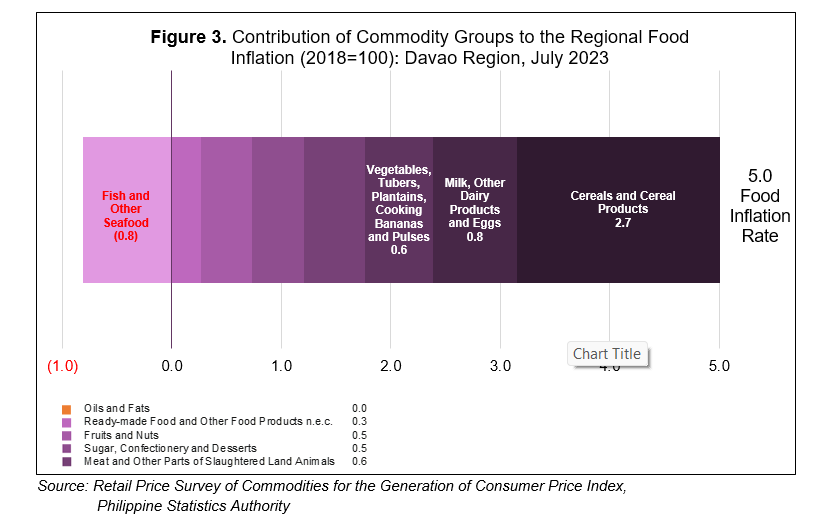
The food groups with the highest contribution to food inflation during the month were the following:
a. Cereals and Cereals Products, which include Rice, Corn, and Flour, Bread and Other Bakery Products, Pasta Products, and Other Cereals, with 2.7 percentage points;
b. Milk, Other Dairy Products and Eggs with 0.8 percentage point; and
c. Vegetables, Tubers, Plantains, Cooking Bananas, and Pulses with 0.6 percentage point. (Figure 3)
4. Regional Inflation Rates

At the national level, the country's headline inflation slowed to 4.7 percent in July 2023, from 5.4 percent in the previous month (Table 4).
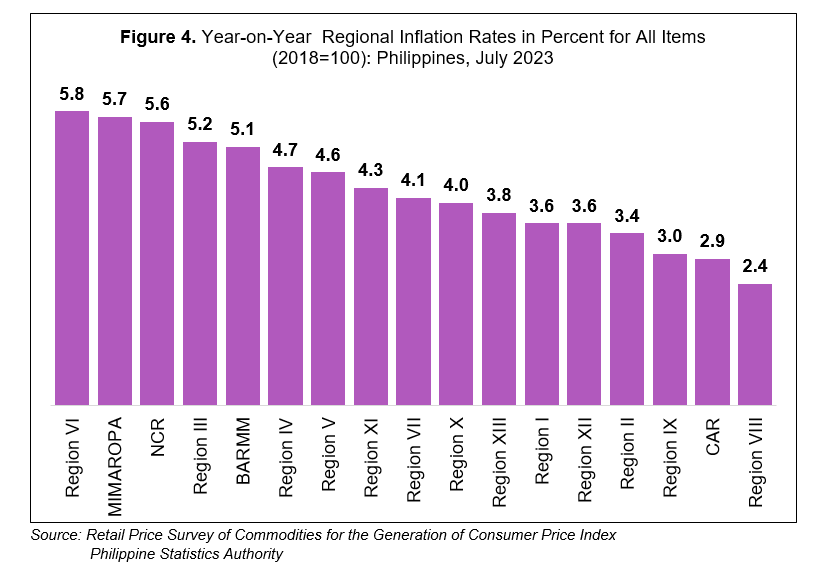
Among the 17 administrative regions, Western Visayas had the highest inflation at 5.8 percent followed by MIMAROPA at 5.7 percent and NCR at 5.6 percent. On the other hand, Eastern Visayas had the lowest inflation at 2.4 percent. (Figure 4)
Note: CPIs and inflation rates by province and selected city are posted at the PSA website (http://openstat.psa.gov.ph/).
APPROVED FOR RELEASE:
RANDOLPH ANTHONY B. GALES
(Chief Statistical Specialist)
Officer-In-Charge
Regional Statistical Services Office 11
